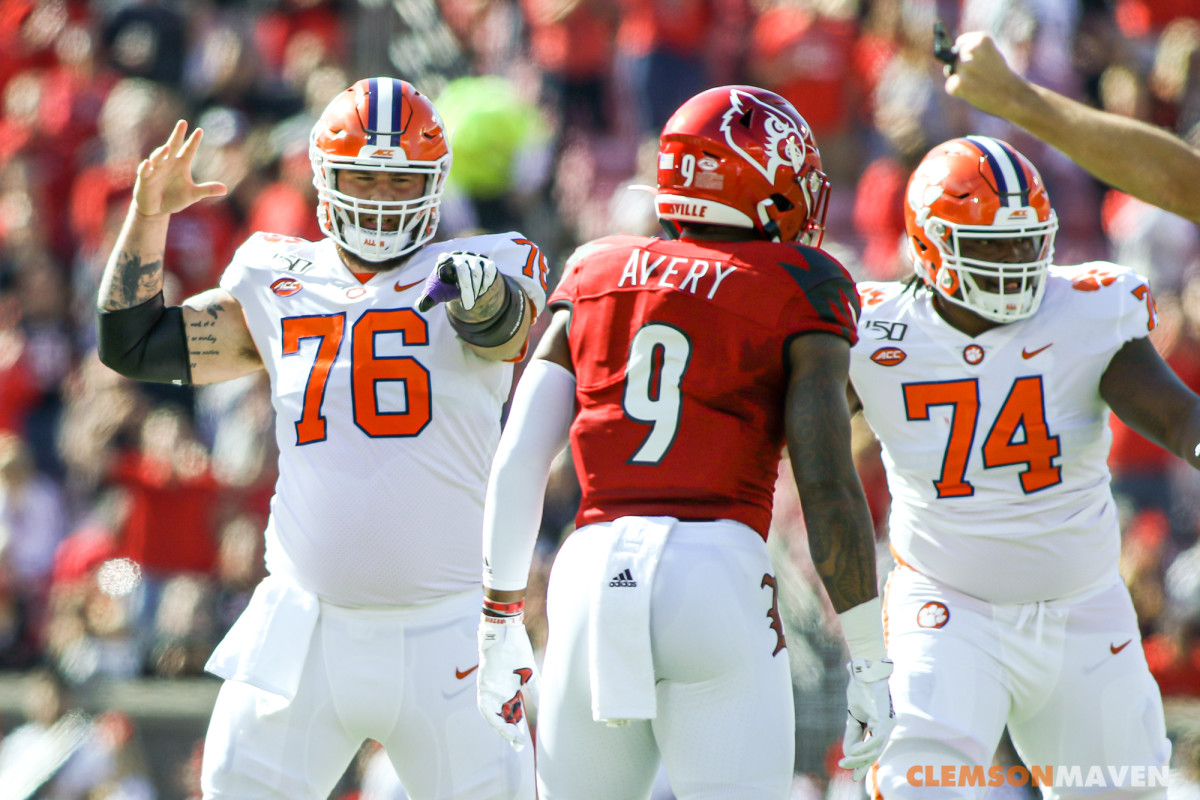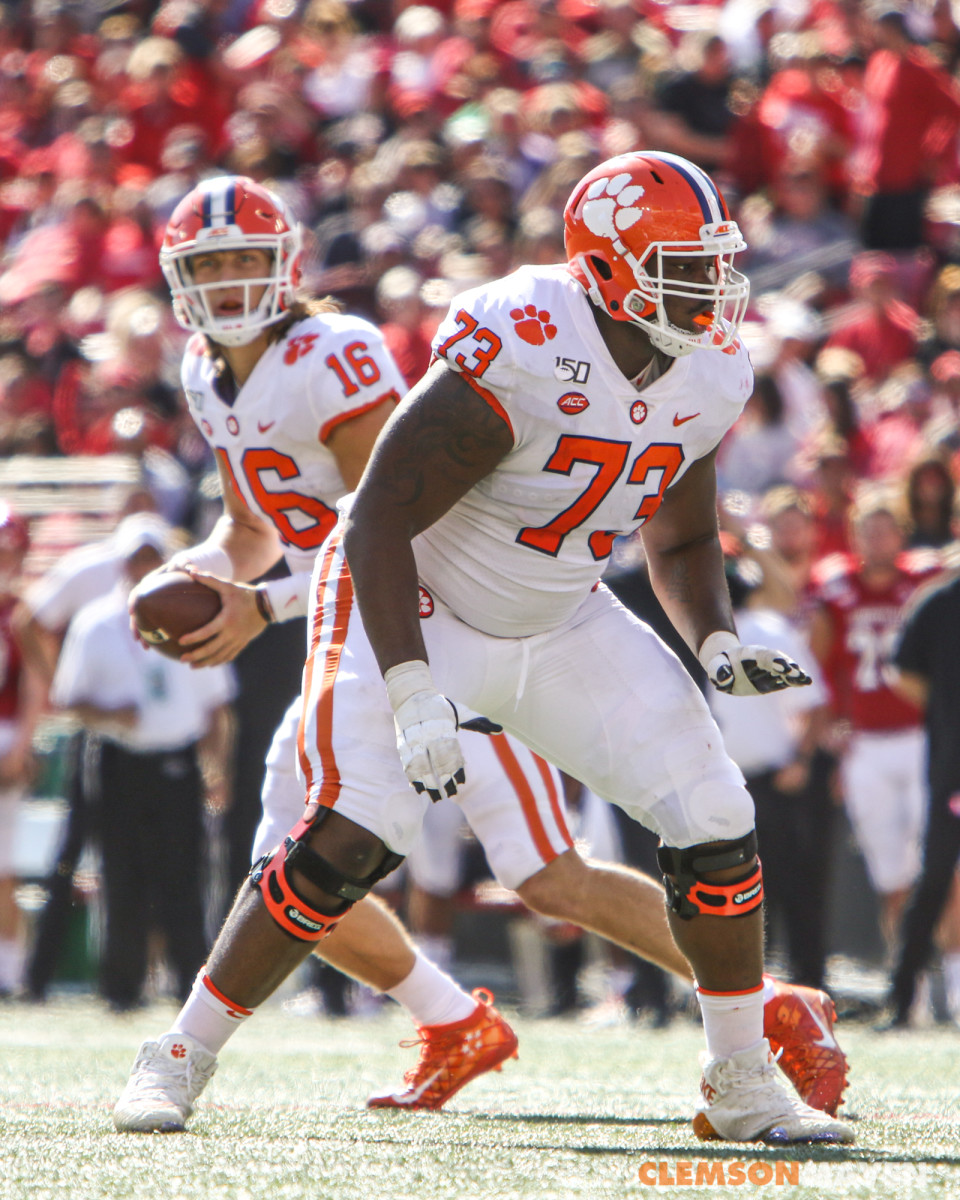OL Review: The All ACC Team

Editor’s note: ClemsonSI is running a series of 10 positional breakdowns each day reviewing the 2019 season.
Clemson’s offensive line had a historical 2019 season that included all five starters earning a spot on the All ACC team.

Position Breakdown:
For the second year in a row Clemson’s star running back, Travis Etienne earned the ACC Player of the Year award. Etienne couldn’t do it alone as he was led by an offensive line that featured five selections to the 2019 All ACC team. Experience paid off for the Tigers as four starters were either playing in their graduate or senior year of eligibility. John Simpson, Sean Pollard, Gage Cervenka and Tremayne Anchrum provided the experience needed to take the Tigers to the national championship game. While the youngest starter on the line was none other than 6’5’’ 345 lbs, 5-star left tackle, Jackson Carman.

Trevor Lawrence and Travis Etienne were able to flourish this season without much worry for their time in the pocket or tackles for loss. While there is a lot to brag about for this group, the main complaint was that of an absence of a traditional running game during the playoffs. Similar to our previous article on the Clemson wide receivers, it is difficult to determine if the lack of success from a traditional run game was due to the offensive line or something else such as defensive scheme or offensive playcalling.
Strengths:
- All five starters named to an All ACC Team
- Successfully kept the pressure off Trevor Lawrence
- Push helped reduce tackles for loss
- Versatile group of athletes
- No. 1 in Rushing Yards from Line of Scrimmage
- No. 1 in Rushing Yards on Passing Downs
- Helped Travis Etienne earn ACC Player of the Year
Clemson only allowed 18 total sacks in 2019 and did not allow a sack against Georgia Tech, Syracuse or Florida State. That put the team at 11th overall in the nation in sacks allowed.

They were also able to consistently get a good push beyond the line of scrimmage as they finished 20th overall in the nation in tackles for a loss allowed. The offensive line helped the running backs become the best in the nation in average yards per carry from line of scrimmage and in average yards per carry on traditional passing downs.
The team was one of the most versatile offensive lines in Clemson's history. Their versatility as both run blockers and pass protectors helped Clemson exceed 200 passing yards and 200 rushing yards in 10 out of 13 games during the season. This performance was only one game shy of the most by any team since 2011.
Some of the team's individual highlights were as follows:
Left guard John Simpson earned consensus All-America status and was only the sixth Clemson offensive lineman to earn the prestigious honor. Simpson also earned a spot on the first-team All ACC Offense.
Right tackle Tremayne Anchrum finished his career allowing the fewest quarterback pressures among ACC tackles and earned a spot on the first-team All ACC Offense.
Center Sean Pollard was originally playing right tackle and right guard before making the switch this year to the center position. He finished the season by being elected to the Second-team All ACC Offense.
Gage Cervenka originally signed with Clemson as a defensive tackle before moving over to right guard. Cervenka joined Pollard on the second-team All ACC Offense as well.
Left tackle Jackson Carman battled with future NFL first-round defensive end Chase Young during the playoff game against the Ohio State Buckeyes. The Tigers left the game with a win and did not allow the pass rusher to earn a sack or a tackle for loss in the game. Carman's efforts this year earned him a spot on the third-team All ACC Offense.
Weakness:
- Short Yardage Success
- Sacks on Passing Downs
- Regular Season vs Playoffs
Statistically, the team finished 41st in Power Success Rate, which looks at the percentage of runs on third and fourth down, two yards or less to go, that achieved a first down or touchdown. In other words, when the Tigers needed just a few yards to keep the ball moving on 3rd and short, they seemed to have difficulty. Looking back, the more obvious it was that the Tigers would run the ball, the less success they had.
The Tigers also had a high percentage of sacks on passing downs, finishing 60th in Pass Downs Sack Rate. Which looks at the percentage of sacks on only passing plays on passing downs.
While the team was dominant in conference play, they couldn’t find a way to have success with a traditional running game during the playoffs. Travis Etienne needed to get out in space in the passing game in order to help the offense move the ball down the field. While Trevor Lawrence took on the role of the running back against Ohio State. Both playmakers had success and won the game. However, the lack of a traditional running game was confusing coming from a team that ranked No. 1 in rushing yards from scrimmage.
It is possible that the above-mentioned rankings could have been inflated due to the level of competition in the conference. We have been reminded more than enough times about the "weak" ACC and for the purpose of this article, we will not take that debate further.
It's still up for debate on what was the actual reason for the lack of a traditional running game during the playoffs. Playing better competition was definitely a factor, however, football is a team sport and while some of the issues might have come from the offensive line, equal share could go to playcalling and defensive schemes.
Overall Grade: A
The Tigers offensive line was manned by a group of experienced and versatile all-conference superstars. While the playoffs presented some difficulties, it doesn't take away from the fact that this group of men was among the most dominant in Clemson history.
